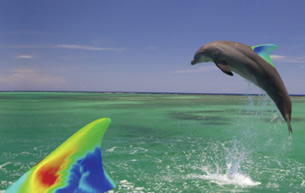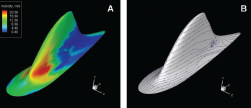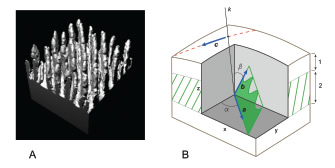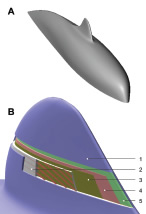Latest News
September 4, 2007
By V.V. Pavlov
 Who knew that Flipper’s highly effective drag reduction adaptations might be worth studying for their possible use in air and sea transport designs? It takes CFD to figure out where the speed originates. |
More recently, advancements in computational fluid dynamics (CFD), which simulates fluid flow and determines velocity, pressure, and temperature anywhere in the solution domain, have created the potential for greatly increasing the understanding of dolphin locomotion. My aim was to use CFD to demonstrate whether the dolphin’s skin functions as a natural anisotropic ]having properties that differ according to the direction of measurement] compliant wall that reduces drag and turbulence.
Quick look back
In the mid-‘30s, Gray measured dolphin speed and then calculated the power required to swim at this speed based on the assumption of a frictional coefficient for a turbulent boundary layer, which is reasonable since dolphins swim at Reynold’s numbers (Re) greater than 106. Assuming that the dolphin’s muscles generate power output per unit weight similar to human athletes, he calculated the power available and determined it was far too small to account for the dolphin’s speed. He noted that at the Re at which dolphins swim, the friction coefficient for a turbulent boundary layer is about 10 times the value for a laminar boundary layer. So the dolphin’s speed could result from a laminar boundary layer.
 Figure 1:CFD results show (A) velocity distribution and (B) velocity vectors on models of the dorsal fin. |
Today, much more detailed information is available on the morphology, physiology, and swimming of dolphins. The state-of-the-art view of dolphin hydrodynamics assumes a complex set of adaptations, such as unsteady velocity and pressure gradients from accelerating water near the body, skin tension, and microvibrations. Just as important, dramatic improvements have been achieved since then in the field of CFD.
CFD can now provide a detailed picture of the flow conditions at any point in the flow domain. CFD software has also gotten much easier to use. A decade ago the CFD codes required the user to have a deep understanding of the computational aspects of fluid dynamics in order to be certain of obtaining accurate results.
 Figure 2: 3D structure of the skin. (A) 3D reconstruction of the papillary layer of the dermis shows the planes of the dermal ridges ending with the dermal papillae. (B) The dashed line indicates the local flow direction on the skin surface. |
In my research, I’ve taken advantage of these developments in CFD to perform the first comparison between the skin morphology parameters of the dolphin’s skin and the flow conditions at various locations on its dorsal fin. The first step was performing physical measurements on the dorsal fins of three harbor porpoises caught in a fishing net in the Black Sea. A total of 20 points were measured on each cross-section and these points were used to generate splines in SolidWorks. Then the free-surface modeling capabilities of the CAD software were used to create a model of the fin. The fin was a good choice for modeling the fluid flow of the dolphin because it has the well-studied wing-like shape. Besides, its shape doesn’t change while swimming, which facilitates the interpretation of the relation between flow and skin parameters.
CAD model used for CFD
The CAD model was then used directly for fluid flow simulation using COSMOSFloWorks CFD software without needing to translate or copy it to a different format.
COSMOSFloWorks has the same underlying technology as the EFD.Lab, EFD.Pro, and EFD.V5 software products from Flomerics. The material properties and boundary conditions required for flow simulation were associatively linked to the model. The software analyzed the CAD model and automatically identified fluid and solid regions without user interaction.
 Figure 3:Modelling of the dorsal fin. (A) Combined model of harbor porpoise. (B) 3D structure of the harbor porpoise dorsal fin: 1 — the upper layer of the epidermis, 2 — the papillary layer, 3 — the subpapillary layer, 4 — the ligamentous layer, 5 — core of the fin. |
Correlations of skin and flow
It was found that skin structure parameters that are important in the flow-skin interface correlate with velocity distribution. To answer the question of whether this correlation explains the drag-reducing properties of the dolphin’s skin, we must look at compliant wall theory.
Frictional forces influence the flow of liquid close to the streamlined body. Due to viscosity, the velocity of the flow increases from zero on the body surface to the free-stream velocity a short distance away. This region is called the boundary layer. A compliant wall suppresses the growth of instabilities in the boundary layer and achieves as much as a five-fold delay in the laminar-to-turbulent flow transition as compared with a rigid wall as shown by Dixon. 2 This effect as well as a favorably modulated turbulent boundary layer leads to the reduction of frictional drag of the streamlined body.
A special kind of surface, called an anisotropic compliant wall, has an advantage of delaying transition in the boundary layer and reducing turbulence as well. Typically, a wall matrix is defined by aligned elements consisting of fibers or voids that provide an ordered inner structure. The structure of the anisotropic wall is arranged so that rather than being displaced up or down by the fluctuating pressure it is displaced in a direction making a substantial angle to the vertical, generating a negative Reynolds shear stress on the compliant surface. Such a response suppresses the instability in the boundary layer, reducing the shear stress level.
The structure of a dolphin’s skin has a similar design to the two-layer anisotropic compliant wall. The epidermis reinforced by the dermal ridges makes possible the anisotropic wall behavior of the skin. The curvature of the leading edge of the fin causes abrupt flow acceleration and the steep gradient of velocity indicates a high level of pressure and shear stress load.
Figure 4: Variability of the flow and the skin structure parameters along the fin cross-section taken at the middle of the fin.Data are normalized from 0 to 1.Bars indicate: 1 — half of the cross section outline, 2 — sin,3 — volume of the papillary layer of the dermis,4 — pressure,5 — velocity,6 — height of the epidermis.
Drag reduction holds the key
In summary, the skin of the dolphin’s dorsal fin appears to be well adapted to local flow conditions during fast swimming. The skin morphology parameters correlate with the alteration of the velocity and pressure along the fin cross-section. The structure of the compliant skin of the dolphin appears to allow for the displacement of the upper layer of skin in the regions of favorable and adverse pressure gradients at the edges of the fin. This flow-skin interface behaves in a manner similar to an anisotropic compliant wall and could suppress the instability growth in the boundary layer.
The highly effective drag reduction adaptations that dolphins have developed over the past 50 million years are worth investigating for their possible use in improving the performance of existing air and sea transport designs.
V.V. Pavlov is a research scientist at Crimean State Medical University in Simeropol, Ukraine. You can send comments about this article via e-mail to DE-Editorsmailto:[email protected].
See also, “Dolphin skin as a natural anisotropic compliant wall,” Bioinspiration & Biomimetics.
References:
1. Kramer MO. 1960b; The dolphin secret,
New Scientist. 7 1118–20.
2. Dixon A E, Lucey A D, and Carpenter PW. 1994; The optimization of viscoelastic compliant walls for transition delay, AIAA J. 32, 256–67.
EFD.Lab, EFD.Pro, EFD.V5
Flomerics
Marlborough, MA
flomerics.com
COSMOS FloWorks CFD
SolidWorks
Concord, MA
solidworks.com
Subscribe to our FREE magazine, FREE email newsletters or both!
Latest News
About the Author
DE’s editors contribute news and new product announcements to Digital Engineering.
Press releases may be sent to them via [email protected].






